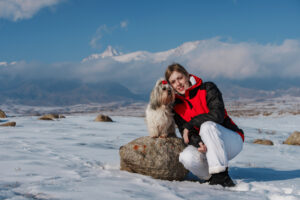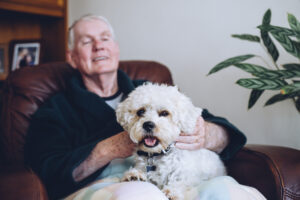Shih Tzus are often chosen for their affectionate personalities, compact size, and adorable appearance. They’re also a top pick for people who want a “hypoallergenic” dog. But while Shih Tzus may be lower on the allergy scale compared to other breeds, they still produce pet dander—and for some people, that can be a real issue.
Understanding how Shih Tzu dander works, and how to manage it, can help you live more comfortably with your pet—whether you already own one or are thinking about bringing one home.
What Makes Shih Tzus Different?
The Shih Tzu’s coat is long, silky, and more like human hair than typical dog fur. This quality leads many people to assume they won’t trigger allergies. While it’s true that Shih Tzus shed less fur than many other breeds, their skin still produces dander—tiny flakes of dead skin—just like any other dog. Their lower-shedding coats may help contain dander to some extent, but it doesn’t eliminate it.
Additionally, the proteins that cause allergic reactions are found not only in a dog’s skin but also in their saliva and urine. Since Shih Tzus love close contact—licking faces, sleeping in laps, and cuddling up on beds—the allergens have more chances to spread throughout the home, especially on fabrics.
Understanding Pet Dander and Allergic Reactions
For people with pet allergies, the issue isn’t fur itself—it’s the proteins attached to dander, saliva, and sometimes dried urine. When these proteins enter the air or come into contact with skin, they can trigger sneezing, watery eyes, itching, or even breathing difficulties.
Shih Tzus, despite their reputation, are not allergen-free. They may be a better choice for allergy-sensitive individuals than high-shedding breeds like Golden Retrievers or German Shepherds, but the allergens are still present. Sensitivity varies from person to person, so while one person might have no reaction to a Shih Tzu, another might experience chronic symptoms.
Signs That Your Shih Tzu Might Be Causing Allergies
Symptoms of dog-related allergies can sometimes be subtle. A stuffy nose that never clears up, red eyes that itch in the evening, or waking up with a scratchy throat might not immediately point to a pet allergy—but they could be connected.
Spending time away from home and noticing an improvement in symptoms is a red flag. If your allergy symptoms improve when you’re not around your Shih Tzu, dander is likely a contributing factor. Consulting an allergist for a skin or blood test can help identify what you’re reacting to and confirm whether your pet is the cause.
Daily Habits That Help Control Dander
You don’t need to give up your Shih Tzu to reduce allergy symptoms. Small, consistent changes in your daily routine can significantly lower the level of dander in your environment. One of the most effective strategies is frequent grooming. Regular brushing removes loose skin cells and prevents buildup in the coat. If you’re allergic, someone else should do the brushing—ideally outside the house.
Bathing your Shih Tzu once every two to four weeks with a gentle, dog-safe shampoo can also help. It keeps the skin healthy, cuts down on dander, and washes away allergens that collect on the fur. Overbathing, though, can dry out the skin and make things worse, so it’s important to find the right balance.
Vacuuming with a HEPA-filter vacuum is essential if you have wall-to-wall carpet or upholstered furniture. Dander sticks to fabric and can linger for months if not properly cleaned. Use washable covers for pet beds and wash them weekly in hot water. Hard surfaces like tile or hardwood are easier to clean and better at preventing buildup.
Creating Pet-Free Zones in Your Home
Limiting where your Shih Tzu can go inside your home makes a big difference. Your bedroom should be off-limits. Dander can settle in bedding, pillows, and curtains and is hard to remove completely. Keeping your sleeping space pet-free can dramatically reduce your overnight exposure to allergens.
Using air purifiers with HEPA filters in main living areas and bedrooms can also help reduce airborne dander. Run them continuously and change the filters as recommended by the manufacturer.
It’s also smart to establish a grooming station or routine outside the house or near an entryway to minimize the spread of allergens indoors. If you’re using a professional groomer, make sure they understand your dog’s needs and use hypoallergenic shampoos.
Managing Allergies Without Giving Up Your Dog
If you’re struggling with symptoms but not ready to part with your Shih Tzu, there are medical options that can help. Over-the-counter antihistamines and nasal sprays can offer relief, but for ongoing issues, an allergist might recommend prescription treatments or even allergy immunotherapy. This long-term treatment gradually desensitizes your immune system to specific allergens and can make a huge difference for pet lovers who don’t want to rehome their animals.
It’s also worth involving your veterinarian. They can recommend skin and coat supplements or specialized diets that support your Shih Tzu’s skin health, reducing flakiness and dander from the source.
What to Know Before Getting a Shih Tzu
If you’re allergy-prone and considering a Shih Tzu, spend some time with the breed before committing. Visit breeders, rescues, or friends with Shih Tzus and see how you react. Allergy symptoms often take hours to develop, so don’t base your decision on a quick interaction.
Remember that puppies may produce less dander than adults, but that changes as they grow. Getting tested for pet allergies before adopting can save you and the dog from a painful decision down the line.




